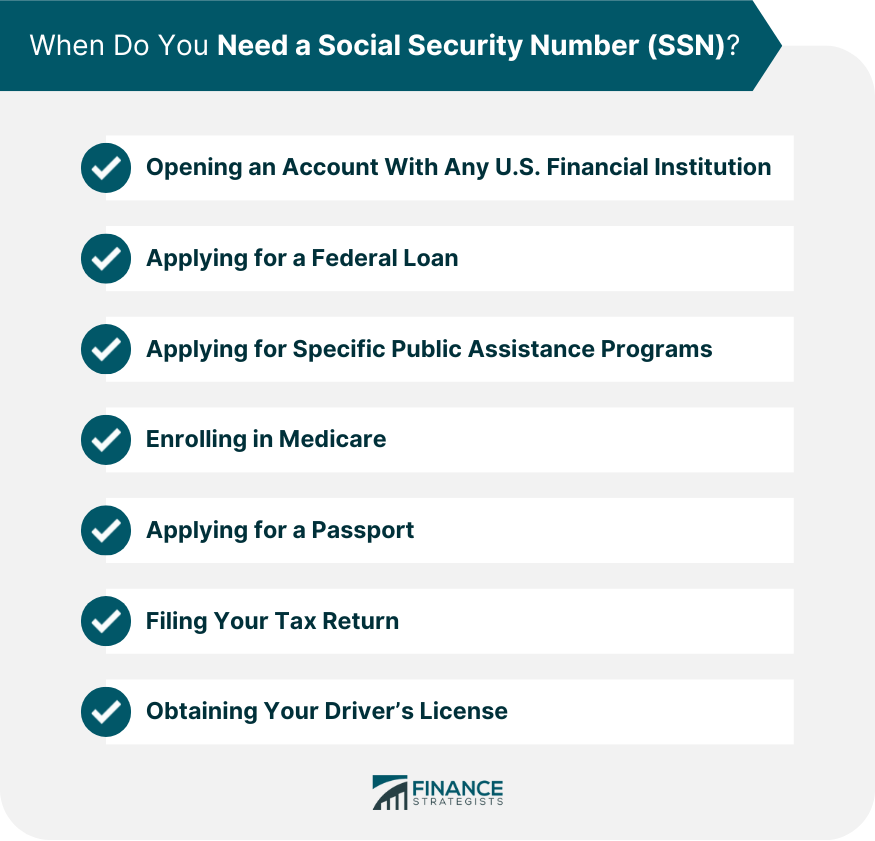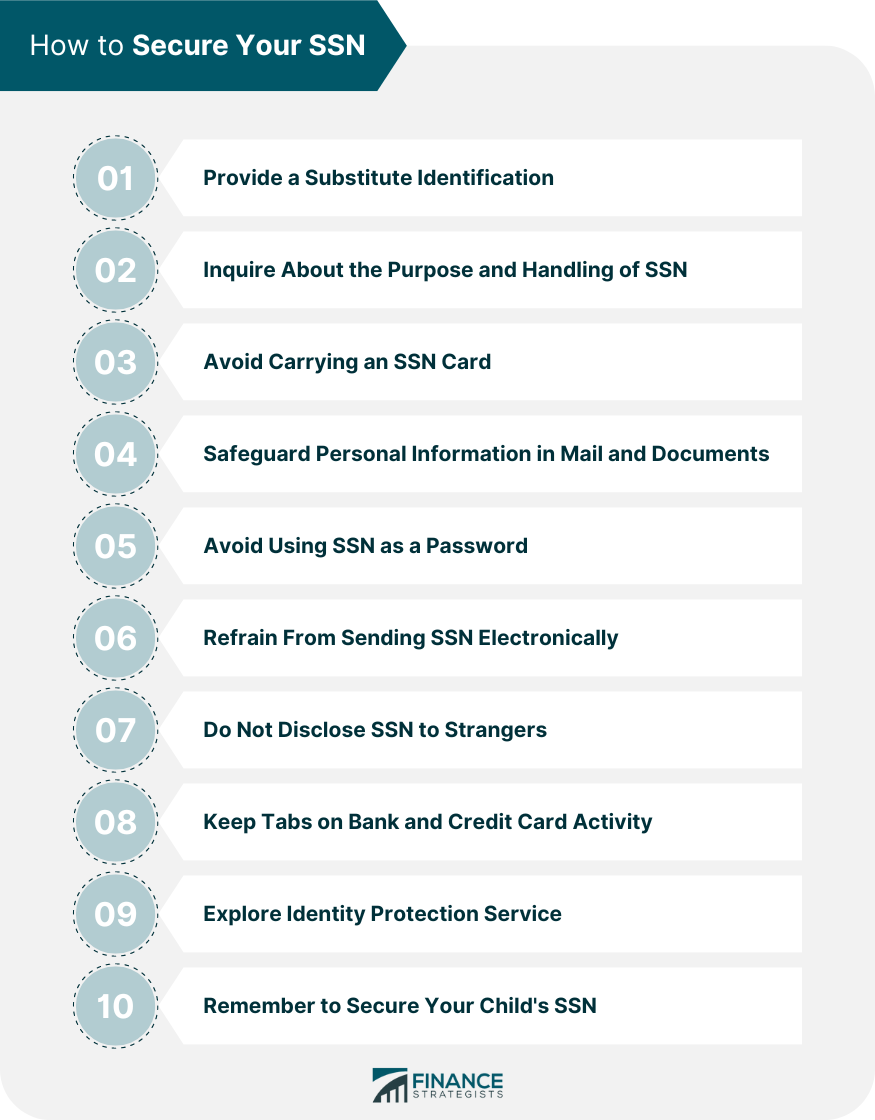A Social Security Number (SSN) is a unique nine-digit number assigned to U.S. citizens, permanent residents, and temporary residents who are authorized to work in the United States. The Social Security Administration (SSA) issues the SSN to keep track of the earnings of the individual and determine their eligibility for Social Security benefits, such as retirement, disability, and survivor benefits. The Social Security Number is used to report earnings to the SSA, which keeps a record of the individual's lifetime earnings and the contributions made to the Social Security program. The Social Security Number works by identifying an individual and tracking their earnings and contributions to the Social Security program throughout their lifetime. The first three digits of the SSN represent the Area Number, the next two show the Group Number, and the last four specify the Serial Number. The SSN numbering scheme was designed to provide a unique identification number to each individual and prevent duplication. The Area Number and Group Number provide information about where and when an SSN was issued, while the Serial Number provides a unique identifier for each individual. Understanding how the SSN works is essential for verifying the authenticity of an SSN and preventing fraud or identity theft. The Social Security Number was created in 1936 as part of the Social Security Act, signed into law by President Franklin D. Roosevelt. The original purpose of the SSN was to track the earnings of workers and determine their eligibility for Social Security benefits. Since then, the use of the SSN has expanded to include various purposes, such as tax filing, financial transactions, and government benefits programs. The Social Security Number is made up of three elements: the area number, the group number, and the serial number. Area Number For SSNs issued prior to June 25, 2011, the first three digits corresponded to the location where the SSN was issued. The Area Number used to be based on the zip code of the mailing address provided on the SSN application at the time of issuance. The first three digits of the SSN ranged from 001 to 772 and were issued in numerical order within each area number, prior to SSN Randomization in 2011. For example, an SSN issued in New York began with the area number 001-003, while one issued in California started with 545-573. At present, the first three digits of the SSN are assigned randomly and include up to the 899. The next two digits of the SSN are used to represent the Group Number, which breaks down the Area Number into smaller segments for administrative purposes. This number ranges from 01 to 99 and is assigned based on the order in which SSNs are issued within each Area Number prior to SSN Randomization. Today, the SSA restricts the assignment of Group Numbers to a particular range, rather than assigning them in numerical order. It is delineated by the final four digits of the SSN. The Serial Number is assigned sequentially within each Group Number. It ranges from 0001 to 9999, with each number assigned in order as SSNs are issued. The Serial Number is unique to each individual and is not reused once an SSN has been assigned. Remember that SSN randomization was implemented by the Social Security Administration in 2011 to enhance the security of SSNs. It involves randomizing the assignment of the Area Number and restricting the assignment of Group Numbers to a particular range, rather than assigning them in numerical order. This process makes it more difficult for fraudsters to guess or obtain SSNs through identity theft. It also increases the validity and availability of SSNs that states can issue since these are not limited geographically anymore. There are several situations when you may be required to present a Social Security Number. Here are some common examples: Financial institutions require an SSN to open a bank account, apply for a credit card, or obtain a loan. Banks, credit unions, and other institutions use the SSN to verify your identity and creditworthiness. Federal loans, such as student loans, require an SSN for identification and tracking purposes. The SSN is used to verify your identity, track your loan status, and report your loan payments to the credit bureaus. Some public assistance programs, such as for unemployment or disability, require an SSN for eligibility determination and tracking. The SSN is used to authenticate your identity and clarify if you are entitled to receive them. To enroll in Medicare, you must have an SSN for identification purposes. The Social Security Number is used to verify your eligibility for medical assistance and to keep track of your enrollment status. An SSN is required to obtain a U.S. passport for identification and tracking purposes. The SSN is used to verify citizenship status. You may be obligated to provide additional documentation without a Social Security Number. You must provide your SSN when filing your tax return to ensure that your earnings are properly reported to the Social Security Administration. The SSN is used to track your earnings and contributions to the Social Security program. Most states require an SSN to obtain a driver’s license or state identification card. The SSN is used to verify your identity and to track your driving record. To obtain a Social Security Number, you must be a U.S. citizen, permanent resident, or temporary resident authorized to work in the United States. You must also provide proof of your age, identity, and citizenship or immigration status. The necessary documents may include your birth certificate, passport, driver’s license, or state ID, and immigration documents, like a work visa or green card. To apply for a Social Security Number, you must complete Form SS-5 and submit it to your local Social Security office. You can also apply online through the Social Security Administration's website if you meet certain criteria. Once your application is processed, you will be issued an SSN card. Protecting your Social Security Number is essential to prevent identity theft and fraud. Here are some tips and best practices for securing your SSN: Whenever possible, use a substitute identification number instead of your SSN. For example, some financial institutions allow you to use a taxpayer identification number (TIN) instead of your SSN. When asked for your Social Security Number, it is crucial to ask why it is needed and how it will be used. If you are not comfortable with the response, consider providing an alternative form of identification. Do not carry your Social Security Number card in your wallet or purse. Store it in a secure location and only take it out when necessary. It is extremely important to have your SSN memorized. Shred or destroy any documents containing your SSN or other sensitive personal information before disposing of them. Be cautious when sharing personal information through email or other electronic means. Do not use your SSN as a password for any account or service. It can be prone to hacking or stealing by savvy identity thieves. Choose strong, unique passwords for each account and change them regularly. Avoid sending your SSN through email, social media, or other electronic means. It is best to provide it in person or at least over the phone. Do not provide your SSN to anyone who contacts you unsolicited or claims to represent a government agency or financial institution. Always verify the identity of anyone with whom you share your SSN. Regularly review your bank and credit card statements for unauthorized transactions or suspicious activity. Your SSN can help safeguard your transactions. Consider enrolling in an identity theft protection service that can help monitor your credit and alert you to any suspicious activity. Children are at risk of identity theft, so it is important to protect their Social Security Number as well. Do not share their SSN unless necessary and monitor their credit report for any suspicious activity. A Social Security Number is a unique identification number assigned to U.S. citizens, permanent residents, and temporary residents authorized to work in the United States. It tracks an individual's earnings and contributions to the Social Security program throughout their lifetime. Understanding how it works is essential for verifying its authenticity and preventing fraud or identity theft. There are many situations when you may need to provide your SSN, such as opening a bank account, applying for a federal loan, enrolling in Medicare, filing taxes, obtaining a passport, and getting a driver’s license. To obtain an SSN, you must provide proof of your age, identity, and citizenship or immigration status. Protecting your SSN is essential to prevent identity theft and fraud. Some tips for securing your SSN include using a substitute identification number, inquiring about the purpose and handling of your SSN, and safeguarding personal information in correspondences. It is crucial to be mindful of your SSN usage and security to prevent identity theft and financial fraud. Consult a qualified retirement planning expert for further information and guidance. Take proactive steps to safeguard your SSN and personal information to avoid financial losses and other untoward consequences.What Is a Social Security Number (SSN)?
How Social Security Number Works
History of SSNs
Components of the SSN
Group Number
Serial Number
When Do You Need a Social Security Number (SSN)?
Opening an Account With Any U.S. Financial Institution
Applying for a Federal Loan
Applying for Specific Public Assistance Programs
Enrolling in Medicare
Applying for a Passport
Filing Your Tax Return
Obtaining Your Driver’s License

How to Get a Social Security Number (SSN)
How to Secure Your SSN
Provide a Substitute Identification
Inquire About the Purpose and Handling of SSN
Avoid Carrying an SSN Card
Safeguard Personal Information in Mail and Documents
Avoid Using SSN as a Password
Refrain From Sending SSN Electronically
Do Not Disclose SSN to Strangers
Keep Tabs on Bank and Credit Card Activity
Explore Identity Protection Service
Remember to Secure Your Child's SSN

Final Thoughts
Social Security Number (SSN) FAQs
You can review your credit reports, monitor your bank and credit card accounts for unauthorized transactions, and check for any suspicious activity on your tax returns or government benefit statements.
If your Social Security Number is stolen, you should report the theft to the Federal Trade Commission (FTC) at 877-382-4357, contact the major credit bureaus to place a fraud alert on your credit report, and notify the Social Security Administration (SSA) to request a new SSN.
Getting a new Social Security Number is a difficult and rare process that requires demonstrating evidence of ongoing harm or abuse related to your current SSN, such as credit or identity theft.
No. It remains the same throughout an individual's lifetime.
U.S. citizens, permanent residents, and temporary residents authorized to work in the United States can apply for a Social Security Number.
True Tamplin is a published author, public speaker, CEO of UpDigital, and founder of Finance Strategists.
True is a Certified Educator in Personal Finance (CEPF®), author of The Handy Financial Ratios Guide, a member of the Society for Advancing Business Editing and Writing, contributes to his financial education site, Finance Strategists, and has spoken to various financial communities such as the CFA Institute, as well as university students like his Alma mater, Biola University, where he received a bachelor of science in business and data analytics.
To learn more about True, visit his personal website or view his author profiles on Amazon, Nasdaq and Forbes.















